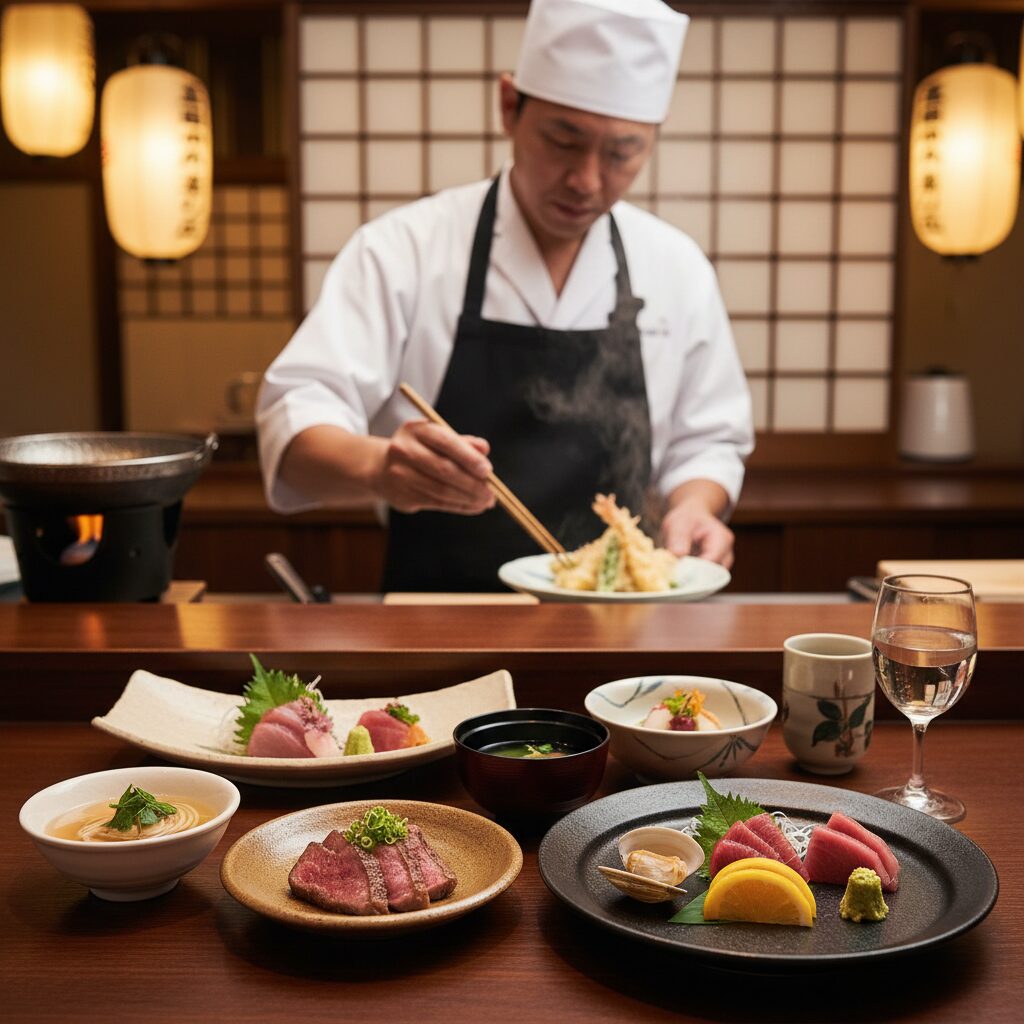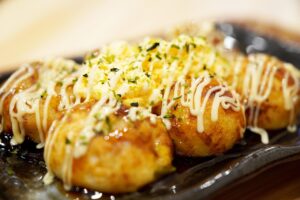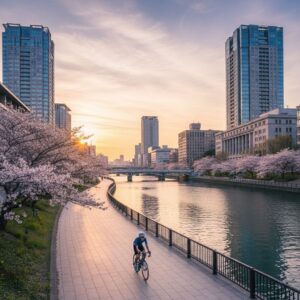There’s a rhythm to Osaka, a pulse that beats loudest in the neon-drenched canyons of Dotonbori and the commercial heart of Umeda. It’s a city that wears its appetite on its sleeve, a place of joyous, boisterous eating. But just a single stop away from the Umeda labyrinth, a different rhythm emerges. Welcome to Fukushima Ward. Here, the city’s frantic energy softens, the streets narrow, and the glow of light is not from towering digital screens, but from the warm, inviting paper of a single lantern hanging beside a discreet wooden door. This is not the Osaka of takoyaki stands and crowded ramen bars. This is a quieter, more refined world, a sanctuary for those who believe that a meal can be a conversation, a performance, and a deeply personal art form. Fukushima is the undisputed heart of Osaka’s intimate Kappo dining scene, a place where the barrier between chef and diner dissolves, and food becomes a story told one exquisite bite at a time. It’s a district for the curious, for the traveler who seeks not just to taste, but to understand. It’s here, in the quiet backstreets, that you will find the soul of Japanese cuisine, served with humility and unparalleled skill across a polished wooden counter.
To further explore Osaka’s hidden culinary gems, discover the city’s soul in the charming alleys of Nakazakicho.
The Soul of Kappo: More Than Just a Meal
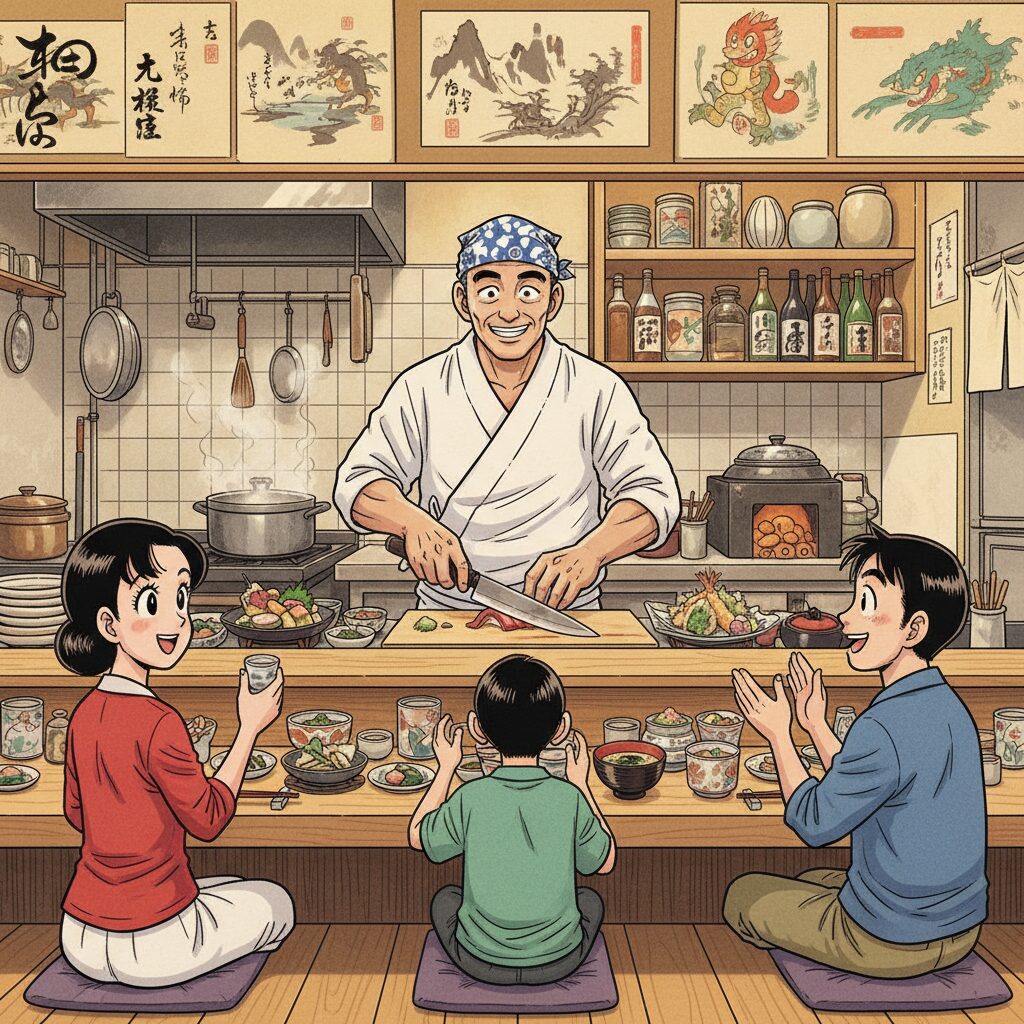
To truly understand Fukushima, you must first grasp the concept of Kappo. The word itself, 割烹, provides a hint: the first character, ‘kappo’, means to cut with a knife, while the second, ‘pou’, means to simmer or stew. It represents cooking in its most fundamental and straightforward form. However, Kappo is more than a set of techniques; it embodies a philosophy of dining. Unlike the highly formal and often secluded world of Kaiseki, where dishes are prepared behind closed doors and served in private rooms, Kappo unfolds directly before you. The counter serves as the stage, the chef, or itamae, is the lead performer, and you, the diner, are the intimate audience of no more than a dozen.
This closeness defines the experience. It creates a unique bond, a silent exchange between creator and consumer. You watch the chef’s hands move in a blur of controlled, graceful motions perfected over decades of relentless practice. The rhythmic tap of a razor-sharp blade on a wooden board, the gentle sizzle of pristine seafood on a hot grill, the fragrant steam rising from a pot of dashi—these are the sounds heralding the birth of your meal. The chef is not merely a cook but your guide for the evening. They read your reactions, adjust the meal’s pace to your rhythm, and might share the story of the fish caught that very morning or the farmer who grew the impossibly sweet tomato you’re about to savor. It is an experience that engages every sense, a culinary performance in which you are part of the cast. In Fukushima, this tradition isn’t just maintained; it is celebrated with quiet confidence. The chefs here are artisans, devoted to their craft with a purity of focus that is both humbling and inspiring. They are masters of seasonality, their menus fluid reflections of the freshest offerings of that very day, that very hour.
Navigating the Labyrinth: Discovering Fukushima’s Culinary Heart
Arriving in Fukushima is an exercise in subtle transition. Whether you step off the JR Loop Line at Fukushima Station or the JR Tozai Line at Shin-Fukushima, the atmosphere shifts instantly. The shadow of the Umeda Sky Building may loom in the distance, but at street level, the scale feels intimate. The main roads give way to a network of roji, the narrow alleys that serve as the true lifeblood of the district. This is where the magic unfolds.
Exploring Fukushima is a journey of discovery. There are no grand arches or flashy signs. The area’s finest Kappo restaurants often appear unpretentious. Look for a simple, well-maintained facade, a beautifully calligraphed menu discreetly displayed outside, or the soft, warm glow filtering through a slatted wooden door. There is a sense of intentional modesty, a belief that the quality of the experience inside speaks for itself. The neighborhood feels vibrant yet tranquil. You’ll hear the distant rumble of trains, cheerful chatter wafting from a local izakaya, and the gentle clinking of glasses. It’s a soundscape of authentic everyday life, the backdrop to extraordinary culinary adventures unfolding behind closed doors.
Most of the notable Kappo establishments cluster around the blocks near the main stations, making the area wonderfully walkable. A pre-dinner stroll is part of the ritual. It helps you shed the energy of the bustling city and attune your senses to the finer details Fukushima offers. Notice the small pottery shops, traditional sweet makers, and the aroma of roasting tea from a tiny storefront. This ecosystem supports the culinary arts—a community built on shared appreciation for craftsmanship and quality. The best way to uncover a truly special spot is to get lost, to wander down an alley that seems to lead nowhere, and to trust in the quiet elegance of a carefully tended entrance. That is where you’re likely to find a meal you will never forget.
The Language of the Counter: An Etiquette for the Uninitiated
Entering a high-end Kappo restaurant for the first time can feel daunting, but the experience is meant to be welcoming and personal. Knowing a few key customs can turn any anxiety into pure enjoyment, allowing you to fully engage with the artistry.
First and foremost is the reservation. The intimate nature of these venues—often with fewer than ten seats—means booking in advance is essential. Spontaneity has little place here. For many top-tier restaurants, reservations are made by phone, sometimes weeks or months ahead. If your Japanese is limited, this can be a challenge. This is where a good hotel concierge becomes invaluable—they can not only make the booking but also communicate any dietary restrictions or preferences you might have. When booking, you will likely be asked to select a price for your omakase course. Omakase translates to “I leave it up to you,” and it is the standard format. You place full trust in the chef to craft a unique, multi-course meal based on the finest ingredients of the day.
Upon arrival, punctuality is crucial. The meal is a performance, and the chef often times the cooking so all guests receive certain dishes simultaneously, ensuring everything is at its peak. When you take your seat at the counter, a simple greeting to the chef, such as “Yoroshiku onegaishimasu,” is a polite way to start the interaction. The counter itself is a sacred space. Avoid placing your phone, bag, or elbows on it. There is usually space behind you or a hook to hang your belongings. As dishes are served, the chef or apprentice will often explain the ingredients and their origins. This is part of the narrative. Feel free to ask questions but be mindful of the chef’s focus, especially during intricate preparations. Quiet appreciation is often the best form of communication.
When it comes to the food, eat each dish as it is served. Kappo dishes are meant to be enjoyed at a specific temperature and texture. Waiting too long does a disservice to the chef’s precise timing. Finally, when the meal ends, a heartfelt “Gochisousama deshita” (Thank you for the meal, it was a feast) is the most important phrase to learn. It expresses deep gratitude for the skill, ingredients, and hospitality you have just experienced.
A Symphony of Seasons
The essence of Kappo cuisine is shun, the concept of seasonality. It reflects a deep, almost spiritual reverence for ingredients at their peak flavor. A true Kappo master’s menu is never fixed; it is a living document, rewritten daily by the tides, the weather, and the earth. Dining in Fukushima across the four seasons offers four distinctly different yet equally profound culinary worlds.
As winter’s chill fades and the first plum blossoms bloom, spring—haru—brings a wave of vibrant, green, and slightly bitter flavors that awaken the palate. The season’s star is often the takenoko, or bamboo shoot, dug fresh from the earth and simmered in delicate dashi broth to highlight its crisp texture and subtly sweet, earthy taste. You will find sansai, wild mountain vegetables foraged from hillsides, such as crisp tempura of fukinoto (butterbur scape), whose pleasant bitterness cleanses the palate. The waters yield sakura-dai, sea bream at its best during cherry blossom season, with skin tinged a beautiful pink. Served as sashimi, its flesh is firm and clean, a pure taste of spring’s ocean. The dishes are light, elegant, and full of the promise of new life.
Summer, or natsu, arrives with sweltering humidity that calls for food that cools and refreshes. This is the season of hamo, the daggertooth pike conger, an eel-like fish riddled with thousands of tiny bones. It requires a masterful technique called honegiri, where the chef makes impossibly fine cuts to render the bones imperceptible, showcasing years of training. The prepared hamo is often blanched, unfolding into a beautiful white bloom, served with a sour plum dipping sauce. Another summer symbol is the ayu, or sweetfish, grilled simply with salt to capture its unique watermelon-like aroma. Cold, clear soups known as osuimono, featuring translucent winter melon or gelatinous junsai (water shield), provide welcome relief from the heat. The flavors are sharp, clean, and invigorating.
When the air cools and leaves turn fiery crimson and gold, autumn—aki—ushers in a time of abundance and deep, earthy flavors. Mushrooms abound, none more prized than the matsutake, with its unmistakable piney, spicy aroma. Simple preparations like charcoal grilling or steaming in a clay pot with rice suffice to showcase its magnificence. The Pacific saury, sanma, is another autumnal sign, its silvery skin blistered on the grill and rich, oily flesh packed with umami. Chestnuts (kuri) and gingko nuts (ginnan) add comforting sweetness and pleasant bitterness to various dishes. Autumn flavors are robust, fragrant, and deeply satisfying—a celebration of the harvest before winter’s scarcity.
Finally, winter, fuyu, blankets the city, and cuisine turns inward to offer warmth and profound depth. This season highlights seafood at its richest. Snow crab from the Sea of Japan, or kani, is served in many ways—the sweet leg meat as sashimi, the rich tomalley grilled in the shell, and the remainder simmered in bubbling hot pots. It is also the season for fugu, the legendary pufferfish, a delicacy requiring a licensed chef. Its subtle flavor and unique chewy texture provide a winter rite of passage for gourmands. The cold waters also produce the best buri, or yellowtail, which becomes fatty and succulent. It might be gently simmered with daikon radish in buri-daikon, a classic Japanese home-cooked dish elevated to fine art. Root vegetables simmered for hours in savory broth bring comfort and foundation. Winter Kappo is a cuisine of deep umami, with concentrated flavors that warm you from within.
Beyond the Counter: Fukushima’s Hidden Charms
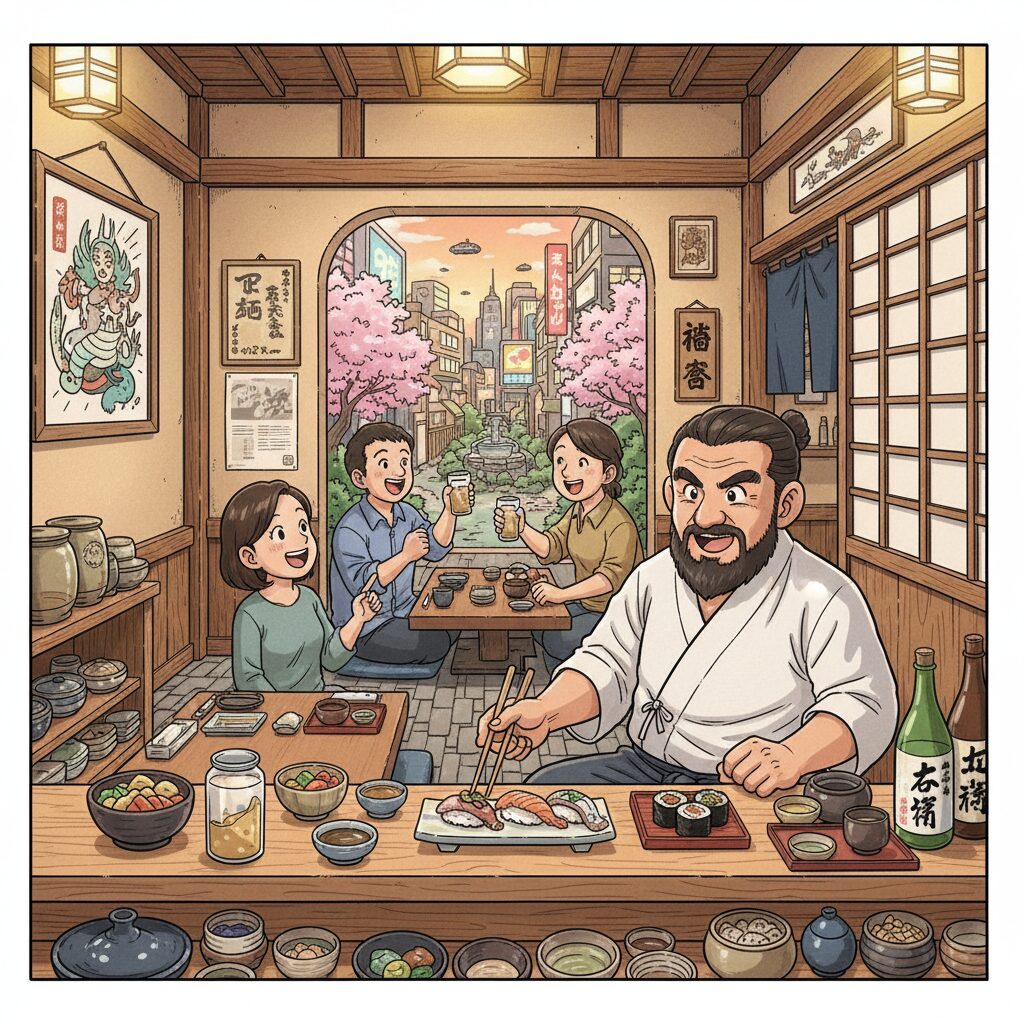
While the Kappo counter is undoubtedly the highlight, the Fukushima neighborhood offers a charming array of experiences that can perfectly complement your evening. This area is not a tourist hotspot; it is a vibrant residential and commercial district, and its genuine character is what makes it appealing. Arriving an hour or two before your dinner reservation allows for a delightful exploration.
One of the most enjoyable ways to get acquainted is to take a stroll toward the waterfront area called Hotarumachi, near the Dojima River. This modern development, featuring broadcast stations and sleek cafes, provides a striking contrast to the traditional alleyways and a scenic view of the water, especially as the sun sets. It’s a peaceful moment before the intense focus of the Kappo meal.
Fukushima is also known for a more casual style of Japanese dining and drinking. The streets are dotted with stylish tachinomi (standing bars), where you can enjoy a quick craft beer or a glass of sake with a small bite. These spots offer a great opportunity to observe locals unwinding after work. You’ll also find excellent bakeries and artisanal coffee shops, perfect for a mid-afternoon break if you explore the area earlier. Exploring the neighborhood’s history adds another layer of appreciation. Fukushima was once a town of merchants and artisans, located near the famous Dojima Rice Exchange, the world’s first futures exchange. This legacy of commerce and refined taste seems woven into the neighborhood’s fabric, perhaps explaining its concentration of quality restaurants.
After your meal, instead of hurrying back to your hotel, consider taking a short walk. The neighborhood reveals a different character at night; the alleys grow quieter, lanterns cast long shadows, and soft sounds from behind closed doors create an atmosphere of mystery and intimacy. A final, quiet moment of reflection while walking through the very streets that house such incredible culinary talent forms the perfect conclusion to a Fukushima Kappo experience.
The Artisan’s Touch: A Glimpse into the Kitchen
What transforms a great Kappo meal into an unforgettable experience are countless details often unnoticed by the untrained eye. It is a world founded on obsessive craftsmanship, extending far beyond the food itself. The chef is more than a cook; they are a curator and artist who orchestrates every element of the experience.
Notice the utsuwa, the vessels presenting your food. In Kappo dining, a plate is never just a plate. It is a carefully chosen piece of pottery or lacquerware, selected to complement the colors, shapes, and textures of the dish. A rough, earthy ceramic bowl might hold a hearty winter stew, while a delicate, hand-painted porcelain dish could cradle a single perfect piece of sashimi. These are seldom mass-produced; often they are antiques or creations by celebrated contemporary artists. The chef builds this collection over a lifetime, and selecting a specific dish for each course is an essential part of their creative expression. The weight of the bowl, the texture of the glaze, the way light reflects off the lacquer—they all contribute to the sensory journey.
Then there is the invisible foundation of nearly every dish: the dashi. This seemingly simple broth, usually made from kombu (kelp) and katsuobushi (dried, fermented, and smoked bonito flakes), is the cornerstone of Japanese cuisine. Pursuing the perfect dashi is a lifelong obsession for a chef. They may discuss the subtle differences in kelp harvested from various regions of Hokkaido, or the precise temperature and timing needed to extract the purest umami without any bitterness. The clear, fragrant broth of an osuimono soup is the purest expression of a chef’s skill. To taste an exceptional dashi is to grasp the profound, elegant simplicity at the heart of Japanese culinary philosophy.
This devotion to craft is evident everywhere: in the razor-sharp knives, polished and maintained like family heirlooms; in the perfect mound of rice, where each grain is distinct yet harmonious; in the careful arrangement of garnishes, placed with the precision of a calligrapher. It culminates thousands of hours of repetition and refinement. When sitting at a Kappo counter in Fukushima, you are not merely paying for dinner—you are witnessing a living tradition of artistry, a dedication to excellence that is both humbling and inspiring.
Your Invitation to the Counter
In a bustling and expansive city like Osaka, it is often the small, concentrated enclaves of culture that leave the most enduring impression. Fukushima Ward is one such spot. It stands as proof that genuine quality doesn’t require fanfare—that a world of deep flavor and artistry can be found behind the simplest of doors. Choosing to dine here means opting for a different kind of travel experience—one that values intimacy over spectacle, conversation over noise, and craftsmanship over convenience.
A meal at a Kappo counter in Fukushima is more than just a culinary highlight; it is a cultural immersion. It offers a chance to connect, however briefly, with an artisan who has devoted their life to their craft. It provides an opportunity to taste Japan’s seasons in their purest form and to appreciate the profound philosophy behind its cuisine. So, when you plan your trip to Osaka, look beyond the bright lights. Take the short train ride to Fukushima. Allow yourself to explore its quiet alleys, follow the gentle glow of a lantern, and push open the door to a small, welcoming space. Take a seat at the polished counter, trust the hands of the master before you, and prepare for a conversation spoken not with words but through the unforgettable flavors of a meal crafted specifically for you. This is the essence of Fukushima, waiting to be discovered.
